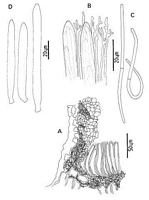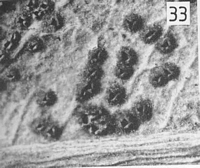|
 Marthamyces emarginatus Marthamyces emarginatus
SynonymsPropolis emarginata
Stictis emarginata
BiostatusPresent in region - Indigenous. Non endemic
Images (click to enlarge)
Caption: Fig. 19 Propolis emarginata: A, ascocarp margin in cross-section. B, apices of asci and
paraphyses. C, released ascospores. D, asci. | 
Caption: Fig. 33 Macroscopic appearance of ascocarp (x 12). Propolis emarginata; |
Article: Johnston, P.R. (1986). Rhytismataceae in New Zealand. 1. Some foliicolous species of Coccomyces de Notaris and Propolis (Fries) Corda. New Zealand Journal of Botany 24(1): 89-124 (http://www.rsnz.org/publish/abstracts.php).
Description: Ascocarps developing on the lower surface of fallen leaves, within indistinct, pale brown
lesions. Ascocarps round in outline, 0.3-0.4 mm diam. Immature ascocarps initially have the
appearance of small, darkened pustules on the leaf surface. The open by several radiate splits
and become semi-erumpent. Covering layer folds back as 3-4 flaps of tissue lined with white
crystals. Hymenium white, pruinose.
Ascocarps subepidermal. In vertical section the immature ascocarp has an upper wall of thin
walled, dark brown hyphae, lined inwardly with a layer of downward projecting, hyaline
periphyses, 5-10 x 2-3 µm, with a few crystals forming in the wall near the centre of the
ascocarp. The lower wall comprises 3-4 layers of dark brown, thin walled hyphae. When
ascocarps open the margin is 70-100 µm wide. It comprises a 10-30 µm wide layer of
brown, thin walled hyphae, 3-5 µm diam., and a 60 µm wide layer of crystals. Periphyses
becoming more or less obscured by the crystals, except near the base of the wall.
Paraphyses 1.5-2 µm diam., sometimes swelling to 3 µm diam. near apex, often with short
side branches, not extending beyond asci. Asci 63-100 x 6-8.5 µm, cylindric with a short,
broad basal stalk, acute apex, uniformly thin walled, non-amyloid, 8-spored. Ascospores
filiform, not tapering, 46-84 x 1.5-2.2 µm, 1-septate, with a gelatinous sheath.
CHARACTERISTICS IN CULTURE: Ascospores germinated on agar plates within 24 h.
After 4 weeks on oatmeal agar, colonies 3.5-4 cm diam., mycelium white to pale grey, dense,
cottony to felted; agar surface undulate, toward centre of colony covered with numerous
fruiting bodies of the teleomorph. Ascocarps globose, dark walled, opening by irregular splits
to expose the grey, pruinose hymenium. Dimensions of hymenial elements same as those
found in nature. Anamorph not formed.
Habitat: Commonly found in New Zealand on fallen leaves of Metrosideros robusta and
M. excelsa, rarely on M. fulgens. P. emarginata has previously been reported as common on
Eucalyptus species from Australia, Asia, and North and South America (Sherwood 1980).
Notes: Sherwood's (1977) description of this fungus does not mention that the ascospores
are 1-septate, and have a gelatinous sheath. These characters are found on both the type
specimen, and the New Zealand collections on Metrosideros. .
Several Coccomyces and Lophodermium species are commonly found on M. fulgens, but
rarely are other Rhytismataceous species found on M. robusta or M. excelsa.
|